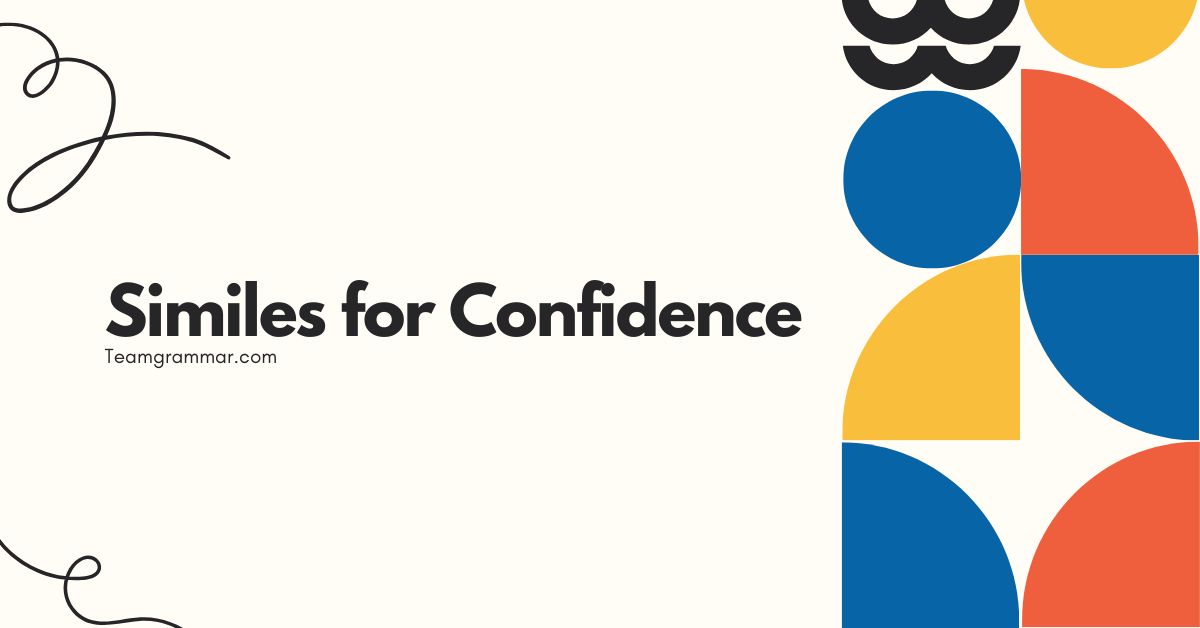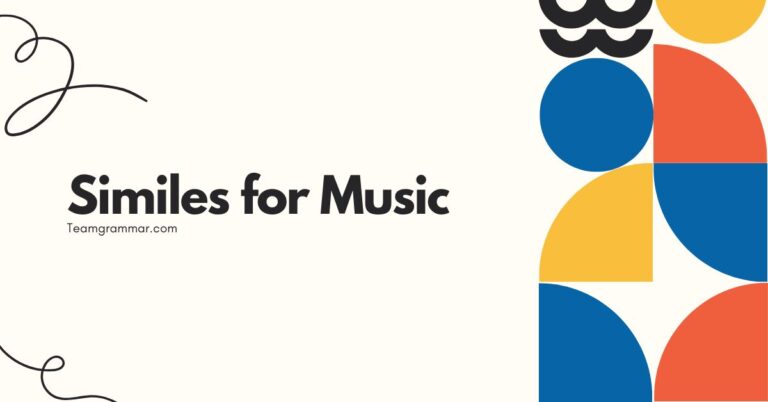37 Similes for Confidence: Mastering Figurative Language
Confidence is a quality admired and sought after, and expressing it effectively can be just as important as possessing it. Similes, a powerful tool in the English language, allow us to convey the strength and assurance associated with confidence in a vivid and memorable way.
By comparing confidence to something familiar, we can paint a picture that resonates with our audience, making our message more impactful and persuasive. This article will explore the art of using similes to express confidence, providing you with the knowledge and examples you need to master this figurative language technique.
This will be beneficial to students, writers, and anyone looking to enhance their communication skills.
Whether you’re crafting a compelling speech, writing a persuasive essay, or simply aiming to articulate your self-assurance in everyday conversation, understanding how to use similes effectively can significantly elevate your expressive capabilities. This guide is designed to equip you with a comprehensive understanding of similes, focusing specifically on their application in conveying confidence.
We’ll delve into definitions, structural breakdowns, diverse categories, usage rules, common mistakes, and practical exercises, ensuring you gain a solid grasp of this valuable linguistic tool.
Table of Contents
- Definition of Similes
- Structural Breakdown of Similes
- Types or Categories of Similes
- Examples of Similes for Confidence
- Usage Rules for Similes
- Common Mistakes When Using Similes
- Practice Exercises
- Advanced Topics in Similes
- Frequently Asked Questions (FAQ)
- Conclusion
Definition of Similes
A simile is a figure of speech that directly compares two different things, highlighting a shared quality or characteristic. The comparison is explicitly made using words such as “like” or “as.” Similes are used to create vivid imagery, emphasize a point, or make a description more relatable and understandable.
They are a fundamental component of figurative language, enriching communication and adding depth to writing.
In essence, a simile takes two disparate concepts and draws a connection between them to illuminate a specific attribute. Unlike metaphors, which imply a direct equivalence, similes acknowledge the distinction between the two things being compared.
This explicit comparison allows for a more nuanced and often more accessible understanding of the quality being described. Similes are frequently used in literature, poetry, and everyday conversation to add color, clarity, and impact to language.
Classification of Similes
Similes can be broadly classified based on the type of comparison they make. Some similes focus on physical attributes, while others highlight emotional states, behaviors, or abstract concepts.
Understanding these classifications can help you choose the most effective simile for your intended purpose.
For instance, a simile comparing confidence to a physical object might be “as solid as a rock,” emphasizing the stability and unwavering nature of the feeling. Conversely, a simile focusing on behavior could be “acting like they own the place,” highlighting the assertive and commanding presence associated with confidence.
The key is to select a comparison that effectively conveys the specific aspect of confidence you wish to emphasize.
Function of Similes
The primary function of a simile is to enhance understanding and create a more engaging experience for the reader or listener. By drawing a comparison to something familiar, similes can make abstract concepts more concrete and relatable.
They also add a layer of depth and richness to language, making it more memorable and impactful.
In the context of expressing confidence, similes can be particularly effective in conveying the strength, certainty, and self-assurance associated with this quality. For example, saying someone is “as confident as a lion” immediately conjures an image of power and dominance, effectively communicating the person’s level of self-assurance.
Similes, therefore, serve as a powerful tool for both description and persuasion.
Contexts for Using Similes
Similes are versatile and can be used in a wide variety of contexts, from formal writing to casual conversation. They are particularly useful in situations where you want to add emphasis, create imagery, or make a complex idea more accessible.
However, it’s important to consider your audience and the overall tone of your communication when choosing a simile.
In professional settings, similes can be used to add impact to presentations or reports, making your message more memorable and persuasive. In creative writing, similes can enhance descriptions and create a more immersive experience for the reader.
In everyday conversation, similes can add color and humor to your language, making you a more engaging communicator. The key is to use similes judiciously and ensure that they are appropriate for the context and audience.
Structural Breakdown of Similes
The basic structure of a simile involves two key elements: the subject being described and the object (or concept) it is being compared to. These elements are connected using the words “like” or “as.” Understanding this structure is crucial for creating effective and grammatically correct similes.
The formula for a simile is straightforward: Subject + “like” or “as” + Object of Comparison. For example, in the simile “He is as brave as a lion,” “He” is the subject, “as brave as” is the comparative phrase, and “a lion” is the object of comparison.
This simple structure allows for a wide range of creative expression while maintaining grammatical clarity.
Key Structural Elements
The essential components of a simile are the subject, the comparative word (“like” or “as”), and the object of comparison. Each element plays a crucial role in conveying the intended meaning and creating the desired effect.
- Subject: The person, thing, or concept being described.
- Comparative Word: “Like” or “as,” which explicitly establishes the comparison.
- Object of Comparison: The person, thing, or concept to which the subject is being compared.
The effectiveness of a simile depends on the careful selection of these elements and their arrangement within the sentence. A well-chosen simile can create a powerful and memorable image, while a poorly constructed simile can be confusing or ineffective.
Common Structural Patterns
While the basic structure of a simile is simple, there are several common patterns that can be used to add variety and complexity to your writing. These patterns often involve the use of adjectives, adverbs, and prepositional phrases to further refine the comparison.
Some common patterns include:
- Subject + is + as + adjective + as + Object: “She is as confident as ever.”
- Subject + verb + like + Object: “He speaks like he knows everything.”
- Subject + verb + as + adverb + as + Object: “She moved as gracefully as a dancer.”
By experimenting with these different patterns, you can create similes that are both grammatically correct and stylistically engaging.
Types or Categories of Similes
Similes can be categorized based on the type of comparison they make, such as comparisons of physical characteristics, emotional states, or behavioral traits. Understanding these categories can help you choose the most appropriate simile for your intended purpose.
Physical Characteristics
These similes compare the physical appearance or attributes of the subject to those of the object of comparison. They often involve descriptions of size, shape, color, or texture.
Examples:
- “His confidence was as solid as a rock.”
- “Her posture was as straight as an arrow.”
Emotional States
These similes compare the emotional state of the subject to a feeling or experience associated with the object of comparison. They often involve descriptions of happiness, sadness, anger, or fear.
Examples:
- “His confidence shone as brightly as the sun.”
- “She felt as secure as a child in her mother’s arms.”
Behavioral Traits
These similes compare the behavior or actions of the subject to those of the object of comparison. They often involve descriptions of movement, speech, or social interactions.
Examples:
- “He acted as confidently as if he owned the place.”
- “She spoke as boldly as a seasoned politician.”
Examples of Similes for Confidence
The following tables provide a variety of examples of similes that can be used to express confidence in different contexts. These examples are categorized to help you find the most appropriate simile for your specific needs.
General Confidence Similes
These similes express a general sense of confidence and self-assurance.
The following table provides 30 examples of similes expressing general confidence. Note the variety of comparisons, from natural forces to animal traits, to convey different nuances of confidence.
| Simile | Explanation |
|---|---|
| As confident as a lion | Implies a strong and dominant presence. |
| As sure as the sun will rise | Highlights unwavering certainty. |
| As steady as a rock | Conveys stability and reliability. |
| As bold as brass | Indicates fearlessness and audacity. |
| As calm as a still lake | Suggests inner peace and composure. |
| As unshakable as a mountain | Emphasizes resilience and strength. |
| As self-assured as a seasoned professional | Highlights experience and competence. |
| As certain as two plus two equals four | Implies absolute certainty and logic. |
| As poised as a ballerina | Conveys grace and self-control. |
| As resolute as a general leading troops | Highlights determination and leadership. |
| As confident as a seasoned performer on stage | Implies comfort and skill in the spotlight. |
| As unwavering as a compass pointing north | Conveys a clear sense of direction and purpose. |
| As self-possessed as a queen | Highlights dignity and authority. |
| As fearless as a firefighter | Indicates bravery and willingness to take risks. |
| As grounded as an ancient tree | Suggests stability and connection to roots. |
| As self-sufficient as a lone wolf | Emphasizes independence and capability. |
| As commanding as a conductor leading an orchestra | Highlights authority and control. |
| As unyielding as a fortress | Conveys strength and resistance to pressure. |
| As self-aware as a wise old sage | Implies deep understanding and insight. |
| As decisive as a chess master | Highlights strategic thinking and quick decision-making. |
| As confident as someone who knows the answer | Highlights a simple, unshakeable feeling of knowing something to be true. |
| As secure as a house built on a foundation of stone | Implies long-lasting, stable confidence that cannot be easily shaken. |
| As strong as a bull | Highlights raw power and strength. |
| As happy with themselves as a child with a new toy | Expresses a feeling of pure, unadulterated joy and confidence within oneself. |
| As comfortable in their own skin as someone at home | They are so secure in who they are that they are always relaxed. |
| As ready for anything as a soldier in battle | Highlights that they have done everything they can to prepare for all possibilities. |
| As bright as a new penny | Implies that they are at their best and shining. |
| As light as a feather | Highlights that they face little resistance and feel weightless. |
| As sure-footed as a mountain goat | Highlights how easily they find their footing in life and how secure they feel with their decisions. |
Situational Confidence Similes
These similes express confidence in specific situations or contexts, such as public speaking, leadership, or problem-solving.
The following table provides 25 examples of similes expressing situational confidence. It’s important to tailor your simile to the specific situation to maximize its impact.
| Simile | Explanation |
|---|---|
| As confident on stage as a seasoned actor | Highlights comfort and skill in public speaking. |
| As decisive in a crisis as a skilled surgeon | Implies quick and effective decision-making under pressure. |
| As persuasive in negotiations as a top lawyer | Conveys strong communication and negotiation skills. |
| As commanding in a meeting as a CEO | Highlights leadership and authority in a professional setting. |
| As confident in their abilities as a master craftsman | Implies expertise and skill in a particular field. |
| As comfortable leading a team as a shepherd with their flock | Highlights the ability to guide and care for others. |
| As prepared for the interview as someone who wrote the questions | Conveys thorough preparation and knowledge. |
| As relaxed during the presentation as if practicing alone | Highlights ease and confidence in a performance setting. |
| As adept at problem-solving as a detective solving a case | Implies analytical and critical thinking skills. |
| As confident in their vision as an artist with a brush | Conveys a clear sense of direction and purpose. |
| As comfortable coding as a fish in water | Highlights someone who is in their element. |
| As natural at teaching as a bird at singing | Highlights someone with a true gift for teaching. |
| As confident at giving directions as a taxi driver | Implies a deep and trusted sense of knowledge. |
| As sure about the next step as a cartographer reading a map | Highlights they know exactly where they are going. |
| As comfortable in the kitchen as a chef | Highlights someone who is in their element in a certain space. |
| As confident in their writing as a famous author | Implies a trusted and respected knowledge. |
| As secure in their dancing as a professional | Highlights their skill and ability. |
| As confident in their work as a builder in a house | Implies that they have a true understanding of the foundations. |
| As confident in their sales pitch as if selling water in the desert | Highlights that they are selling something so important and needed that it is a sure thing. |
| As comfortable at the gym as a body builder | Highlights how secure and comfortable they are in their own skin. |
| As confident in their ability to read people as a psychic | Implies a deep and unnerving sense of understanding. |
| As relaxed in the ocean as a marine biologist | Highlights someone who is in their element. |
| As prepared for the test as a valedictorian | Highlights that one has gone above and beyond in their preparations. |
| As ready to fight as a soldier | Implies that one has prepared for everything to come. |
| As confident in their singing as a pop star | Highlights that someone is extremely comfortable with their talent. |
Internal Confidence Similes
These similes express an inner sense of confidence and self-worth, independent of external validation or circumstances.
The following table provides 20 examples of similes expressing internal confidence. These comparisons focus on inner strength and personal conviction.
| Simile | Explanation |
|---|---|
| As confident in themselves as a child who knows they are loved | Highlights unwavering self-worth and security. |
| As grounded in their values as a tree with deep roots | Implies a strong moral compass and sense of integrity. |
| As content with their path as a river flowing to the sea | Conveys a sense of purpose and direction. |
| As at peace with their imperfections as a potter with their clay | Highlights self-acceptance and embracing flaws. |
| As secure in their identity as a lighthouse in a storm | Implies resilience and unwavering self-belief. |
| As confident in their voice as a singer | Highlights someone who is comfortable and confident in their own skin. |
| As comfortable in their shoes as someone at home | Highlights someone who is relaxed and secure in themselves. |
| As free from doubts as a child at play | Implies a pure and uninhibited self-belief. |
| As clear about their worth as a diamond | Conveys a sense of inherent value and importance. |
| As connected to themselves as one with nature | Highlights self-awareness and inner harmony. |
| As sure of their next step as if they saw the future | Implies clarity and a sense of destiny. |
| As comfortable with themselves as if they are at home | Highlights that they are secure and relaxed in their own skin. |
| As unbothered by what others think as a monk | Highlights a sense of inner peace and freedom from external validation. |
| As happy with themselves as a child with a new toy | Implies pure, unadulterated self-acceptance and joy. |
| As content with their bodies as someone who loves to dance | Highlights an appreciation for one’s physical self and abilities. |
| As free from fear as a bird in the sky | Conveys a sense of limitless possibility and liberation. |
| As sure of their place as a king on his throne | Implies a sense of authority and belonging. |
| As trusting of themselves as a child with their parents | Highlights a deep sense of security and self-belief. |
| As full of love for themselves as someone who is in love | Conveys a sense of self-compassion and appreciation. |
| As connected to themselves as a tree is to its roots | Highlights a strong sense of identity and grounding. |
Usage Rules for Similes
While similes are a powerful tool for creative expression, it’s important to follow certain usage rules to ensure clarity and effectiveness. These rules cover aspects such as grammatical correctness, logical comparisons, and avoiding clichés.
Grammatical Correctness
Similes must adhere to basic grammatical rules to be effective. This includes using the correct form of “like” or “as,” ensuring subject-verb agreement, and maintaining consistent tense.
For example, it is grammatically correct to say “She is as confident as he is,” but incorrect to say “She is as confident as him.” Pay attention to the grammatical structure of your similes to avoid errors.
Logical and Relevant Comparisons
The comparison made in a simile should be logical and relevant to the quality being described. The object of comparison should possess the attribute being emphasized in a clear and recognizable way.
For instance, comparing someone’s confidence to a “gentle breeze” might not be effective, as a gentle breeze does not typically connote strength or certainty. A more logical comparison might be “as confident as a hurricane,” which conveys a sense of power and force.
Avoiding Clichés
Clichés are overused phrases that have lost their impact due to frequent use. While some common similes can be effective, it’s important to avoid clichés and strive for originality in your comparisons.
Instead of saying “as strong as an ox,” which is a common cliché, try a more creative and specific comparison, such as “as strong as a steel girder.” The goal is to create a fresh and memorable image that resonates with your audience.
Common Mistakes When Using Similes
Even experienced writers can make mistakes when using similes. Understanding these common errors can help you avoid them and improve the quality of your writing.
Incorrect or Illogical Comparisons
One of the most common mistakes is making comparisons that are illogical or don’t make sense. This can confuse the reader and detract from the intended meaning.
Incorrect: “His confidence was as fragile as a brick wall.” (A brick wall is not fragile)
Correct: “His confidence was as fragile as a house of cards.”
Overuse of Similes
Using too many similes in a short space can make your writing feel cluttered and distracting. It’s important to use similes sparingly and only when they add significant value to your description.
Overuse: “He was as confident as a lion, as brave as a soldier, and as strong as an ox.”
Better: “He was as confident as a lion, radiating strength and assurance.”
Mixing Similes and Metaphors
Combining similes and metaphors in a way that creates a confusing or contradictory image is another common mistake. It’s important to maintain consistency in your figurative language.
Incorrect: “His confidence was like a rock, but it was also a fragile flame.” (Mixing a simile with a contradictory metaphor)
Correct: “His confidence was like a rock, solid and unwavering.”
Practice Exercises
The following exercises will help you practice using similes to express confidence. Each exercise includes a set of questions or prompts, followed by suggested answers.
Exercise 1: Identifying Similes
Identify the simile in each of the following sentences:
| Question | Answer |
|---|---|
| 1. She approached the presentation as confidently as a seasoned speaker. | As confidently as a seasoned speaker |
| 2. His belief in himself was as strong as steel. | As strong as steel |
| 3. He felt like he could conquer the world. | like he could conquer the world |
| 4. Her poise was as natural as breathing. | As natural as breathing |
| 5. He stood tall, like a monument to self-assurance. | like a monument to self-assurance |
| 6. She was as sure of her path as a river flowing to the sea. | As sure of her path as a river flowing to the sea |
| 7. He remained calm, like the eye of a hurricane. | like the eye of a hurricane |
| 8. Her voice resonated as powerfully as a clap of thunder. | as powerfully as a clap of thunder |
| 9. He presented his case as persuasively as a skilled lawyer. | as persuasively as a skilled lawyer |
| 10. Her conviction was as unwavering as a compass pointing north. | as unwavering as a compass pointing north |
Exercise 2: Completing Similes
Complete the following similes to express confidence:
| Question | Answer |
|---|---|
| 1. He spoke with a confidence as clear as __________. | crystal |
| 2. Her self-assurance was as radiant as __________. | the sun |
| 3. He moved as gracefully as __________. | a swan |
| 4. She stood as tall as __________. | a skyscraper |
| 5. His belief in himself was as unshakeable as __________. | a mountain |
| 6. She felt as comfortable in the spotlight as __________. | a star |
| 7. He led the team as confidently as __________. | a general |
| 8. Her determination was as strong as __________. | steel |
| 9. He approached the challenge as fearlessly as __________. | a lion |
| 10. Her voice was as commanding as __________. | a queen’s |
Exercise 3: Creating Similes
Create your own similes to describe the following scenarios:
| Scenario | Suggested Simile |
|---|---|
| 1. A confident public speaker | He was as confident on stage as a rock star at a concert. |
| 2. A self-assured leader | She led the team as confidently as a seasoned captain guiding a ship. |
| 3. A person who believes in themselves | His belief in himself was as unwavering as the North Star. |
| 4. Someone who is comfortable in their own skin | She was as comfortable in her own skin as someone at home. |
| 5. A confident problem-solver | He approached the problem as confidently as a chess master. |
| 6. A person at peace with themself | She was as sure of her path as a river flowing to the sea. |
| 7. A confident artist | He painted as confidently as if he had been doing so for years. |
| 8. An assured dancer | She moved as confidently as a professional dancer. |
| 9. A confident worker | He approached his work as if everything was coming naturally to him. |
| 10. A confident friend | She was as confident in her friendship as if she were with family. |
Advanced Topics in Similes
For advanced learners, there are several more complex aspects of similes to explore, including the use of extended similes, the creation of original comparisons, and the incorporation of similes into more sophisticated writing styles.
Extended Similes
An extended simile is a simile that is developed over several sentences or even paragraphs. This allows for a more detailed and nuanced comparison, creating a richer and more vivid image.
Example: “Her confidence was like a sturdy oak tree, its roots firmly planted in the earth, its branches reaching towards the sky, weathering every storm with unwavering strength.”
Creating Original Comparisons
While using common similes can be effective, creating original comparisons can make your writing stand out and demonstrate your creativity. This involves thinking outside the box and finding unexpected connections between seemingly disparate things.
Example: “His confidence was like a perfectly tuned engine, humming with power and precision.”
Similes in Sophisticated Writing Styles
Similes can be incorporated into more sophisticated writing styles, such as literary fiction or academic prose, to add depth and nuance to your descriptions. However, it’s important to use similes judiciously and ensure that they are appropriate for the tone and audience of your writing.
Example: “Her confidence, like a carefully constructed argument, was built on a foundation of solid evidence and logical reasoning.”
Frequently Asked Questions (FAQ)
Here are some frequently asked questions about similes, along with detailed answers to help you further understand this concept.
- What is the difference between a simile and a metaphor?
A simile explicitly compares two things using “like” or “as,” while a metaphor implies a direct equivalence without using those words. For example, “He is like a lion” is a simile, while “He is a lion” is a metaphor.
- Can a simile be a cliché?
Yes, a simile can become a cliché if it is overused. It’s important to strive for originality and avoid using tired, predictable comparisons.
- How can I make my similes more effective?
Choose logical and relevant comparisons, avoid clichés, and use vivid language to create a strong image in the reader’s mind. Also, ensure that your similes are grammatically correct and consistent with the tone of your writing.
- Is it okay to use multiple similes in one paragraph?
While it’s possible to use multiple similes in one paragraph, it’s generally best to use them sparingly to avoid cluttering your writing. Focus on quality over quantity and choose the most impactful similes for your descriptions.
- How do I avoid making illogical comparisons in my similes?
Carefully consider the qualities you are trying to emphasize and choose objects of comparison that clearly possess those qualities. Ask yourself if the comparison makes sense and if it creates a clear and understandable image.
- What is an extended simile?
An extended simile is a simile that is developed over several sentences or paragraphs, allowing for a more detailed and nuanced comparison than a simple simile.
- How do I create original similes?
Think outside the box and look for unexpected connections between seemingly disparate things. Brainstorm different objects or concepts that possess the qualities you are trying to describe and choose the most unique and impactful comparison.
- Can similes be used in formal writing?
Yes, similes can be used in formal writing, but it’s important to use them judiciously and ensure that they are appropriate for the tone and audience of your writing. Avoid using overly casual or colloquial similes in formal contexts.
- How do similes improve writing?
Similes improve writing by adding depth, clarity, and vividness to descriptions. They help to create a more engaging and memorable experience for the reader by drawing comparisons to familiar concepts and creating strong images.
- What role do adjectives play in similes?
Adjectives play a crucial role in similes by helping to refine the comparison and emphasize specific qualities. They add detail and nuance to the description, making the simile more effective and impactful.
Conclusion
Mastering the use of similes to express confidence is a valuable skill for anyone looking to enhance their communication abilities. By understanding the definition, structure, types, and usage rules of similes, you can effectively convey the strength, certainty, and self-assurance associated with confidence in a vivid and memorable way.
Remember to avoid common mistakes, practice regularly, and strive for originality in your comparisons.
Similes are a powerful tool for adding depth, clarity, and impact to your writing and speaking. By incorporating them into your communication, you can create a more engaging and persuasive message that resonates with your audience.
Whether you’re crafting a compelling speech, writing a persuasive essay, or simply aiming to articulate your self-assurance in everyday conversation, mastering the art of using similes will significantly elevate your expressive capabilities. Embrace the power of figurative language and unlock your full potential as a communicator.
Remember, practice makes perfect. The more you experiment with similes and incorporate them into your writing and speaking, the more natural and effective they will become.
So, go forth and use the power of similes to express your confidence with clarity, creativity, and
creativity, and impact.







